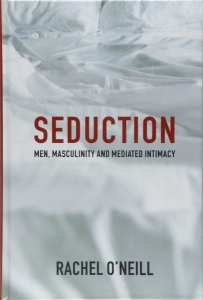In Seduction: Men, Masculinity and Mediated Intimacy, Rachel O’Neill examines the construction of intimacy under neoliberalism through an ethnographic exploration of the contemporary ‘seduction industry’. With the book providing deep insight into the complexities and contradictions that organise and shape masculine subjectivities within this controversial community, Sophie Hales recommends this as essential reading for all those interested in gender, sexuality, the commercialisation of intimacy and ethnographic research more generally.
Seduction: Men, Masculinity and Mediated Intimacy. Rachel O’Neill. Polity. 2018.
In Seduction, Rachel O’Neill turns her interest in gender, feminist theory and sexuality toward the commercialisation of intimacy in this ethnographic exploration of the seduction industry. With a particular emphasis on heteronormative masculinity, O’Neill offers a critical and comprehensive analysis of this controversial community that addresses the gendered and sexual systems underpinning the industry. In doing so, she highlights issues of power and inequality that have, until now, remained largely unexplored in work on this sector of consumerism. For this reason, Seduction makes a compelling text for anyone interested in gender and sexuality in the contemporary political and commercial landscape. With its core focus on the lived experiences of those who work within and consume the seduction industry (both trainers and participants) and its adoption of a reflexive ethnographic approach, the book also provides a useful reference point for any researchers interested in this methodology.
O’Neill’s ethnography concerns what has become known as the ‘seduction industry’: a community in which intimacy and sexual relations are conceived as knowledge-based practices constitutive of a skillset that can be learned, taught and mastered. This community has evolved into a highly organised industry delivering seduction seminars, running ‘bootcamps’ and providing ‘in the field’ training for men wishing to have more frequent sexual interactions with women. Within this pedagogic approach to seduction, the promise of not only skill acquisition but also mastery of them is a promotional strategy underpinning the industry. With the participants of the ‘seduction community’ almost exclusively heterosexual men, O’Neill’s year-long ethnography departs from existing studies concerned with sex and relationship advice for women, a longstanding tendency, to instead focus on an industry marketed for and developed by men. Based in London, O’Neill documents fieldwork observations and interviews with both consumers and trainers within the industry, capturing the lived experiences of those invested in the community as they participate in classroom and ‘in the field’ training activities.
At its core, Seduction explores how neoliberal and postfeminist discourses shape the ways in which intimate relationships are understood, negotiated and managed. The seduction community provides a useful example of how intimacy and sexual relationships become standardised and largely exploitative processes within a consumerist context that positions intimacy as a commodity. A notable consequence of this is that genuine intimacy, for those invested in the seduction community, (perhaps not surprisingly) becomes more difficult to experience.
O’Neill begins by introducing the seduction community as a site of mediated intimacy rooted in Rosalind Gill’s ‘intimate entrepreneurship’, shaped largely through neoliberal ideology whereby individuals are responsible for the success or failure of their intimate lives. The first chapter, ‘The Work of Seduction’, considers how management and enterprise rationalities organise masculine subjectivities, cultivating a sexual work ethic such that intimacy may be approached in a similar fashion to that of work or study. This organisation of intimacy manifests, as O’Neill explains, through rating the perceived beauty of sexual conquests and the quantity of sexual encounters as markers of masculine worth and social status. Following this logic, so-called pick-up artistry must be studied laboriously to achieve the desired status. Through this opening discussion, O’Neill demonstrates how ‘within the seduction community, already tenuous distinctions between life and work under neoliberalism are decidedly collapsed’ (22).
Having explained intimacy within the seduction community as situated in a neoliberal marketplace, Chapter Two, ‘Pedagogy and Profit’, develops a critique of the commercial strategies employed in the marketing and delivery of ‘pick up’ as a pedagogical imperative. These strategies thrive – profit – on an ideology of predatory masculinity, while simultaneously exploiting the insecurities of consumers within the seduction industry through the promotion of a ‘specifically homosocial formation’ (55) in order for consumers to achieve heterosexual affirmation. In other words, through bonding with other men in the community over a shared interest in seduction, a form of sociality that would otherwise be unavailable to them, they become able to realise ‘normative conventions of what it means to be a man’ (58).
Building on the pedagogy of seduction, the third chapter details how the standardisation of intimacy is put into practice through a systematisation of sex. Perhaps the most uncomfortable reading in this chapter, entitled ‘Manufacturing Consent’, is the concept of ‘last minute resistance’, which refers to objections to sexual advances made by women during ‘pick ups’ that are positioned as token resistance to be overcome. The industry prescribes methods to overcome so-called ‘LMR’, and in doing so normalises resistance and positions securing consent as part of ‘the game’.
Following this, O’Neill develops the discussion into one of the power and politics of intimacy, emphasising how the twin rationalities of neoliberalism and postfeminism reorganise understandings of intimate life. The seduction industry provides a particularly vivid illustration of this, which O’Neill explains in this section of the book, by focusing on the means through which seduction ‘functions as a way for men to both gain greater control in the intimate realm and to address perceived imbalances in the gender order’ (121). O’Neill concludes with her position ‘Against Seduction’, arguing against the particular packaging of intimacy and the manipulation of others found within the seduction community, also highlighting that this entrepreneurial approach to sexual relations makes genuine intimacy increasingly more difficult to create and sustain. As she puts it, the calculated display of emotion ‘all the more convincingly substitutes for feeling’ (156).
The postscript contains O’Neill’s reflections on her experiences as a feminist researcher navigating the seduction community within which men are promised mastery over women. Of particular value is the frank and reflexive account O’Neill provides of the emotional complexities, and at times burden, that are perhaps inevitably compounded into the process. This forms an especially useful point of reference for any ethnographic researchers interested in researching a community that may be controversial, marginalised or otherwise difficult to access.
In sum, Seduction provides a fascinating exploration of the ‘pick-up’ industry, demonstrating how discourses around neoliberalism and postfeminism increasingly shape contemporary life, including the most intimate of encounters. Without doubt, there are many moments in this book that make for uncomfortable reading, but necessarily so in order for O’Neill to provide such insight into the complexities and contradictions making up the organisation of masculine subjectivities within the seduction community. Given this, it is essential reading for students and researchers with interests in gender, sexuality and culture, the commercialisation of intimacy and in ethnographic research more generally.
Note: This review gives the views of the author, and not the position of the LSE Review of Books blog, or of the London School of Economics.
Image Credit: (Maria Rantanen CC BY SA 2.0).


 Find this book:
Find this book: 






1 Comments